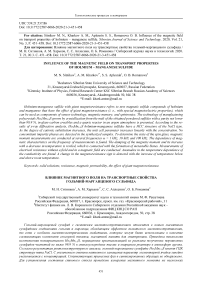Influence of the magnetic field on transport properties of holmium – manganese sulfide
Автор: M. N. Sitnikov, A. M. Kharkov, S. S. Aplesnin, O. B. Romanova
Журнал: Siberian Aerospace Journal @vestnik-sibsau-en
Рубрика: Technological processes and material science
Статья в выпуске: 3 vol.21, 2020 года.
Бесплатный доступ
Holmium-manganese sulfide with giant magnetoresistance refers to new magnetic sulfide compounds of holmium and manganese that have the effect of giant magnetoresistance (i. e., with special magnetoelectric properties), which can be used as components of sensor technology, magnetic memory, and spintronics. The technology of manufacturing polycrystals HoXMn1-XS grown by crystallization from the melt of the obtained powdered sulfides with a purity not lower than 99,9 %, in glass-carbon crucibles and a quartz reactor in an argon atmosphere is presented. According to the results of x-ray diffraction analysis, HoXMn1-XS holmium-manganese sulfides have a HCC structure of the NaCl type. As the degree of cationic substitution increases, the unit cell parameter increases linearly with the concentration. No concomitant impurity phases are detected in the synthesized samples. To determine the state of the spin glass, magnetic moment measurements are conducted at several frequencies ω = 1 kHz, 10 kHz and 100 kHz. The dependence of magnetic characteristics on the frequency of measurements is found. The damping of the magnetic moment and its increase with a decrease in temperature is reviled, which is connected with the formation of metastable States. Measurements of electrical resistance without a field and in a magnetic field are conducted. Anomalies in the temperature dependence of the conductivity are found. A change in the magnetoresistance sign is detected with the increase of temperature below and above room temperature.
Solid solutions, resistance, magnetic permeability, the effect of giant magnetoresistance.
Короткий адрес: https://sciup.org/148321768
IDR: 148321768 | УДК: 539.21:537.86 | DOI: 10.31772/2587-6066-2020-21-3-451-458
Текст научной статьи Influence of the magnetic field on transport properties of holmium – manganese sulfide
Introduction. The microelectronics element base, functioning on the basis of the magneto resistive effect [1], can operate under extreme conditions. Materials with the effect of giant magnetoresistance (GMR) can be used as components of sensor technology [2], magnetic memory [3] and are able to change their electrical resistance in several times under external magnetic field application [4–7].
Summing up, it is possible to say that all currently known GMR substances are complex (oxide) phases based on manganese oxides, the ferromagnetism of ions of which is responsible for the GMR effect emerging [8]. Oxide compounds of manganese type La1-xAхMnO3 (A = Ca, Sr, Ba, etc.) and methods for their preparation [8; 9] are known. The maximum amplitude of this effect is observed in the immediate vicinity of the transition to the ferromagnetic state, at high values of the Curie temperature ТС ~ 250÷400 K and opens up broad prospects of their technological application.
The drawback of these substances is the high sensitivity of lanthanum manganite to concentration of a divalent impurity, a high melting point T ~ 1800–1900 oC, the cost of their constituent elements and realization of the GMR effect in a narrow temperature interval near the magnetic transition temperature. NaCl-type fcc lattice.
The vanadium chromium disulfide – copper CuVXCr1-XS2 is also known (rhombohedral structure, space group R3m), which belongs to the class of mixed electron-ion semiconductors and is an antiferromagnetic with critical temperatures of superionic ( T su = 670 K) and magnetic ( T N ~ 40 K) transitions [10]. The effect of negative magnetoresistance in this compound is observed at 77 K in a magnetic field of 10 kOe and is – 40 %. This effect is observed only in polycrystalline samples but not in single-crystal samples with a copper deficiency.
The drawback of disulfides CuVXCr1-XS2 is not a simple layered structure, the complexity of the crystal growth technology because of the high mobility of copper ions and low temperatures at which negative magnetoresistance arises. NaCl-type fcc lattice
In the initial manganese monosulfide α-MnS (an antiferromagnetic with NaCl-type fcc lattice), anisotropy of the electrical resistivity for two crystallographic directions [111] and [100] in the temperature range of 77–300 K [11–13] was found. A negative magnetoresistance was also found, the value of which in a field of 10 kOe is –12 % and most clearly showed in the (111) plane [14]. With an increase of the magnetic field, the magnitude of the magnetoresistance does not change, but the minimum shifts to the low temperature range.
The main drawbacks of manganese monosulfide are the small magnitude of the magneto resistive effect, the energy consumption of the synthesis technology, and the low operating temperatures of magneto resistive elements on the basis on such materials.
The technically closest to the claimed invention is ferromanganese sulfide FeXMn1-XS [15–17], containing components in the following ratio, atom%: Fe 12.5–20; Mn 30–37.5 and S-50 and having a simple cubic structure such as NaCl. With an increase in the degree of cationic substitution (X) in the FeXMn1-XS system, a semiconductor – semimetal transition with Xc = 0.4 and an increase in magnetization are observed, with the Néel temperature increasing from 150 K for X = 0 and to 210 K for X = 0.2. Ferromanganese sulfide has GMR in the temperature range of 50 K – 250 K with the maximum development of the HMS effect (δ H = –83 %) at 160 K in the magnetic field H = 10 kOe and δ H = –450 % at 50 K in the field H = 30 kOe.
The drawback of the known ferromanganese sulfides FeXMn1-XS is the poor repeatability of the compounds obtained, the complexity and duration of the synthesis.
The aim of this work is to obtain magnetic compounds of holmium – manganese sulfides with a cubic NaCl lattice type, which have a stable and repeating effect of giant magnetoresistance in a wide temperature range.
Experimental results and their discussion. Obtaining method and radiograph. Three compositions of HoXMn1-XS were prepared; they are shown in tab. 1 in atomic%.
HoXMn1-XS crystals were grown by crystallization from a melt of the obtained powder sulfides with a purity of at least 99.9 %, in glassy carbon crucibles and a quartz reactor in an argon atmosphere; NH4CNS was used as sulfiding reagents. The calculated mixture of oxides in a glassy carbon boat was placed in a quartz tube. After the air was displaced by argon and the decomposition products of ammonium thiocyanate, the furnace was turned on from a separate reactor. The synthesis was carried out in two stages: heating the mixture to 500 °C with keeping at this temperature for 1 hour; after grinding – repeated sulfiding for 3 hours at 7500–8000 °C. For completeness of sulfiding and homogenization of the resulting powder sulfide, annealing was carried out for 30 hours in a sulfiding atmosphere at 800 °С with repeated grinding of sulfides. The completeness of sulfidation was controlled by X -ray phase analysis and weight control.
For crystallization from sulphide melt, high-frequency heating of a graphite crucible 10 mm in diameter filled with 6–7 g of sulphide powder was used. A quartz reactor with a crucible was pulled at a speed of 0.5 to 1 cm / h through a single-turn inductor. The inert atmosphere in the reactor was maintained with argon. To obtain a sulphide melt, the necessary parameters of the power supplied to the inductor were determined experimentally. As a result of the synthesis, substances were obtained in the form of dense ingots. The obtained samples were homogeneous in composition and were used for physical measurements.
According to the results of X-ray diffraction analysis, the holmium-manganese sulfides HoXMn1-XS have a NaCl-type fcc lattice [18]. With an increase of the degree of cationic substitution, the unit cell parameter a increases (fig. 1). No accompanying impurity phases were found in the synthesized samples.
Magnetization and magnetoresistance. The replacement of manganese with holmium ions leads to a significant change of the magnetic properties of the samples of the holmium-manganese system HoXMn1-XS. A sharp decrease in the paramagnetic Curie temperature as a result of the competition of exchange interactions and a decrease in the effective magnetic moment occurs. The microscopic mechanism of a decrease of exchange and magnetic moment is associated with a change in the electronic structure of manganese ions interacting with holmium ions. Ferromagnetic exchange interaction between man- ganese and holmium ions leads to an increase in the magnetic susceptibility with decrease of the temperature.
The competition of exchange interactions results in two possible variants: the disappearance of long-range magnetic order with the formation of a spin glass state [19; 20], or preservation of magnetic order in one of the spin components and with frozen transverse spin components (asperromagnetic state) [21; 22]. To determine the nature of this state, we are to measure the magnetic moment at several frequencies.
In the spin glass state, the time during which thermodynamic equilibrium is set depends on the temperature; the magnetic characteristics depend on the measurement frequency. The magnetic moment in an alternating magnetic field, shown in fig. 2, below T = 30 K depends on the frequency. Thus, the relative change of Re (M (ω = 10 kHz) –M (ω = 100 Hz)) / Re (M (ω = 100 Hz)) increases with the holmium concentration growth and Re (M (T)) reveals its maximum at T = 5 K, which is missing in HoS.
Table 1
|
Composition |
Ho, % |
Mn, % |
S, % |
|
I |
10 |
40 |
50 |
|
II |
17.5 |
32.5 |
50 |
|
III |
20 |
30 |
50 |
20 40 60 80 100
2 0, degree
Fig. 1. The lattice constant of holmium-manganese sulfide Ho X Mn 1- X S versus concentration and x -ray for x = 0.3
Рис. 1. Постоянная решетки гольмий-марганцевого сульфида Ho X Mn1- X S от концентрации и рентгенограмма для х = 0,3
0,0 0,1 0,2 0,3
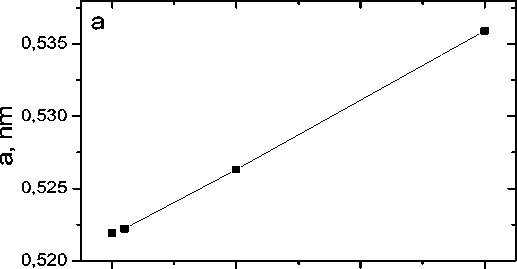
0,3
0,0 b
0,1 0,2
x, mol.%
"w
c
(311) (400)(420)(422)
0,535
0,530
0,525
0,520
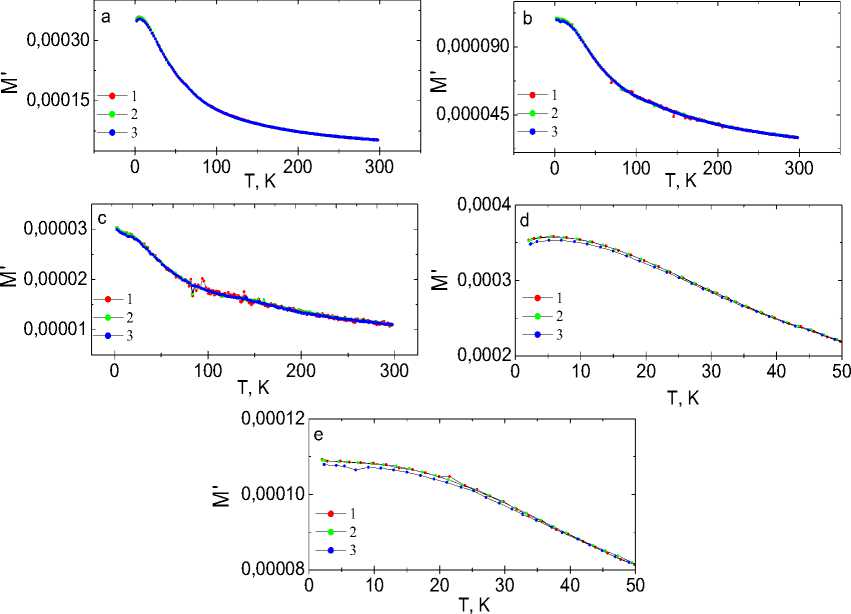
Fig. 2. The Real part of the magnetic permeability ( a , b , c ) and the imaginary part ( d , e ) of the temperature for Ho X Mn 1- X S with x = 0.3 ( a , d ), 0.1 ( b , e ), 0.05 ( c ) at three frequencies ω = 1 kHz ( 1 ), 10 kHz ( 2 ), 100 kHz ( 3 )
Рис. 2. Реальная часть магнитной проницаемости ( a , b , c ) и мнимая часть ( d , e ) от температуры для Ho X Mn1- X S с х = 0,3 ( а , d ), 0,1 ( b , e ), 0,05 ( c ) на трех частотах ω = 1 kHz ( 1 ), 10 kHz ( 2 ), 100 kHz ( 3 )
The imaginary part is practically independent from temperature and has the value Im (M ( T )) ~ 10–7 for concentrations x ≤ 0.1 and Im (M ( T )) is qualitatively different in the low-temperature range (fig. 2, d ) for a composition with x = 0.3. The quantity Im (M ( T )), which characterizes the decay of the magnetic moment, increases with temperature decreasing, and the derivative dIm (M) / dT passes through a maximum at T = 39 K at a frequency of ω = 1 kHz, at T = 44 K for ω = 10 kHz. An increase in the temperature of the maximum of the derivative of the imaginary part of the magnetic moment with frequency increasing is also connected with the formation of metastable states and is a characteristic feature of spin-glass behavior. It is possible that the spin relaxation mechanism is connected with the exchange interaction of localized and delocalized electrons, and the energy from the spin system is converted into the kinetic energy of current carriers [23; 24].
Replacement of manganese with a rare earth element in ReXMn1-XS (Re = Gd, Sm, Ho) compounds [25; 26] will result in a shift of the f-level. Several variants are possible in this case, the f-level falls into the conduction band, and the electron passes from the Re ion not to the d-level of the rare-earth ion, but to the conduction band, remaining connected with the donor. If the concentration of such centers is low, less than the critical concentration for impurity band or the percolation threshold formation, then the substance will remain a semiconductor. If the f-level is located in the forbidden band near the chemical potential, extremum may appear in the temperature dependence of the resistance when the chemical potential is shifted with temperature increase [27; 28].
Substitution of manganese by a trivalent ion will cause electron doping and may induce orbital ordering [29–31], which will result in the splitting of the electron density of states. Depending on the location of the Fermi level relative to the split density of states, the electrical resistivity can change several times [32; 33].
In fig. 3, 4 the temperature dependences of the electrical resistance measured without and in a magnetic field are shown. The magnetoresistance is determined by the formula, ex ρ(H≠0)-ρ(H=0) δ= ⋅100%,
H ρ ( H ≠ 0)
where ρ ( Н = 0) ) is the electrical resistance in a zero magnetic field, ρ ( Н ≠ 0) is the electrical resistance in a given magnetic field.
The magnetoresistance for compositions with х = 0.05 and х = 0.1 indicates that in the synthesized substances in the temperature range 100 K – 300 K, the effect of giant negative magnetoresistance is observed with the maximum effect of GMR in a magnetic field H = 8 kOe; the value of δ H , % is –100 and –80 %, respectively.
Tab. 2 shows the main physical characteristics of the HoXMn1-XS holmium-manganese sulfide system.
3,0x106
2,5x106
2,0x106
Е 6
§ 1,5x106
± 1,0x106
5,0x105
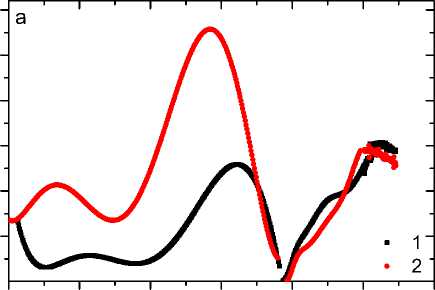
100 150 200 250 300 350 400
0,8
0,4
о, Qi
0,0
о
т
^- -0,4
-0,8
T, K
--------1-----------1-----------1-----------1-----------1-----------1-----------1-----------1-----------1-----------Г" b
----------1-------------1-------------1-------------1-------------1-------------1-------------1-------------1-------------1-------------Г—
100 150 200 250 300 350 400
T, K
Fig. 3. Resistance Ho X Mn 1- X S with x = 0.1 measured without a field ( 2 ) and in a magnetic field H = 8 kOe ( 1 ) ( a ). Magnetoresistance at temperature ( b )
Рис. 3. Сопротивление Ho X Mn1- X S с х = 0,1, измеренное без поля ( 2 ) и в магнитном поле Н = 8 kOe ( 1 ) ( а ). Магнитосопротивление от температуры ( b )
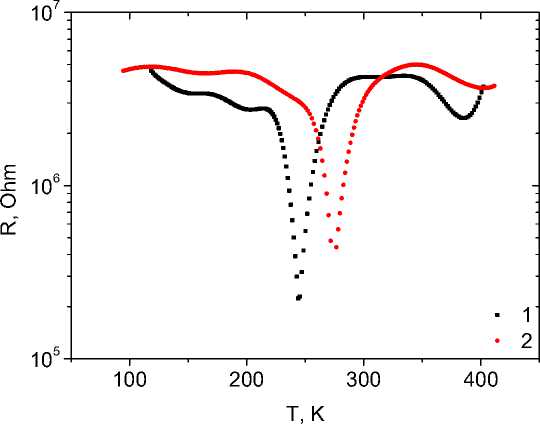
Fig. 4. Resistance Ho X Mn 1- X S with x = 0.05 measured without a field and in a magnetic field H = 8 kOe
Рис. 4. Сопротивление Ho X Mn1- X S с х = 0,05, измеренное без поля и в магнитном поле Н = 8 kOe
Table 2
|
Ho X Mn1- X S |
a , nm |
–Θ, K |
T N , K |
δ H , % ( H = 8 kOe) |
ρ, Ом·см T = 300 K H = 0 |
|
I ( X = 0.05) |
0.5242 |
140 |
145 |
100 |
2·107 |
|
II ( X = 0.1) |
0.5256 |
100 |
134 |
80 |
3·105 |
|
III ( X = 0.2) |
0.5303 |
60 |
112 |
30 |
104 |
Where a, nm is the crystal lattice parameter; Θ, K – paramagnetic Curie temperature; Ea, eV – activation energy; T N , K is the Neel temperature; δ H , % – magnetoresistance; ρ, Ohm cm – resistivity at 300 K.
Conclusion. The replacement of manganese with holmium leads to a sharp decrease in the paramagnetic Curie temperature as a result of the competition of exchange interactions in the solid solution and to a reduction of the effective magnetic moment in the concentration range 0 < X < 0.1. The microscopic mechanism of exchange and magnetic moment decrease is connected with the change of the electronic structure of manganese ions interacting with holmium ions. Ferromagnetic exchange interaction between manganese and holmium ions causes an increase of the magnetic susceptibility with decreasing temperature in the magnetically ordered phase. The frequency dependence of the magnetic permeability at low temperatures and the maximum of the imaginary part of the magnetic permeability for X = 0.3, which is connected with freezing of the transverse spin components, is found.
In solid solutions HoXMn1-XS, a sharp maximum in the conductivity with respect to temperature is found, which shifts towards low temperatures in a magnetic field. A change in the sign of the magnetoresistance is reviled with an increase in temperature below and above room temperature. The results obtained can be used as perspective materials for spintronic, as components of sensor technology, magnetic memory based on the GMR effect for a wide range of temperatures and magnetic fields.
Acknowledgments. The work was supported by the Siberian State University youth grant, SibGU, 2020.
Список литературы Influence of the magnetic field on transport properties of holmium – manganese sulfide
- Fert A. Nobel Lecture: Origin, development, and future of spintronics. Rev. Mod. Phys. 2008, Vol. 80, P. 1517.
- Barthelemy, A. Handbook of Magnetic Materials / A. Barthelemy, A. Fert, F. Petroff; ed. by K.H.J. Buschow. Amsterdam: North Holland. 1999, Vol. 12, P. 1–96.
- Volkov N. V. [Spintronics: magnetic tunnel structures based on manganites]. UFN. 2012, Vol. 182, P. 263 (In Russ.).
- Romanova O. B., Aplesnin S. S., Udod L. V., Sitnikov M. N., Kretinin V. V., Yanushkevich K. I., Velikanov D. A. Magnetoresistance, magnetoimpedance, magnetothermopower, and photoconductivity in silverdoped manganese sulfides. J. Appl. Phys. 2019, Vol. 125, P. 175706.
- Aplesnin S. S., Sitnikov M. N., Kharkov A. M., Masyugin A. N., Kretinin V. V., Fisenko O. B., Gorev M. V. Influence of induced electrical polarization on the magnetoresistance and magnetoimpedance in the spindisordered TmxMn1-xS solid solution. Phys. Stat. Sol. B. 2019, P. 1900043.
- Bebenin N. G., Zainullina R. I., Ustinov V. V. [Manganites with colossal magnetoresistance]. UFN. 2018, Vol. 188, P. 801–820 (In Russ.).
- Aplesnin S. S., Sitnikov M. N. [Magnetotransport effects in the ferromagnetic state in GdxMn1-xS]. ZhETF. 2014, Vol. 100, P. 104–110 (In Russ.).
- Nagaev E. L. [Lanthanum manganites and other magnetic semiconductors with giant magnetoresistance]. UFN. 1996, Vol. 166, No. 8, P. 796–857 (In Russ.).
- Kagan M. U., Kugel K. I. [Inhomogeneous charge states and phase separation in manganites]. UFN. 2001, Vol. 171, P. 577–596 (In Russ.).
- Abramova G. M., Petrakovsky G. A., Vtyurin A. N., Vorotynov A. M., Velikanov D. A., Krylov A. S., Gerasimova Yu., Sokolov V. V., Bovina A. F. Magnetic properties, agnetoresistance, and Raman spectra CuVXCr1-XS2. FTT. 2009, Vol. 51, Vol. 3, P. 500–504.
- Aplesnin S. S., Petrakovskii G. A., Ryabinkina L. I., Abramova G. M., Kiselev N. I., Romanova O. B. Influence of magnetic ordering on the resistivity anisotropy of α-MnS single crystal. Solid State Communications. 2004, Vol. 129, Iss. 3, P. 195–197.
- Aplesnin S. S., Ryabinkina L. I., Romanova O. B., Sokolov V. V., Pichugin A. Y., Galyas A. I., Demidenko O. F., Makovetski G. I., Yanushkevich K. I. Magnetic and electrical properties of cation-substituted sulfides MeXMn1-XS (Me = Co, Gd). Physics of the Solid State. 2009, Vol. 51, Iss. 4, P. 698–701.
- Aplesnin S. S., Ryabinkina L. I., Abramova G. M., Romanova O. B., Vorotynov A. M., Velikanov D. A., Kiselev N. I., Balaev A. D. Conductivity, weak ferromagnetism, and charge instability in an α-MnS single crystal. Phys. Rev. B. 2005, Vol. 71, No. 1, P. 125204–125212.
- Aplesnin S. S., Ryabinkina L. I., Romanova O. B. et al. [Magnetoresistance properties of solid solutions MnSe1-xTex]. FTT. 2007, Vol. 49, P. 1984 (In Russ.).
- Petrakovskii G. A., Loseva G. V., Ryabinkina L. I., Aplesnin S. S. Metal insulator transition and magnetic properties in disordered systems of solid solutions MexMn1-xS. JMMM. 1995, Vol. 140, P. 147–148.
- Aplesnin S. S., Kharkov A. M., Sokolov V. V. Gigantic magnetocapacitive effect into YbxMn1-xS. Abstract for Euro-Asian Symposium “Trends in magnetism”, EASTMAG, Vladivostok. 2013, P. 33–34.
- Aplesnin S. S., Moskvin A. I. [The influence of strong electron correlations and interactions of electrons with the lattice on the electron orbital ordering]. ZhETF. 2010, Vol. 92, No. 4, P. 254–259 (In Russ.).
- Aplesnin S. S., Kharkov A. M., Sitnikov M. N., Sokolov V. V. Spin reduction in the HoXMn1-XS solid solution. JMMM. 2013, Vol. 347, P. 10–13.
- Aplesnin S. S. [Role of fluctuation relations for the transport properties in manganites and nichelato]. ZhETF. 2007, Vol. 131, No. 5, P. 878–884 (In Russ.).
- Aplesnin S. S., Ryabinkina L. I., Romanova O. B., Bandurina O. N., Gorev M. V., Balaev A. D., Eremin E. V. [Spin-glass effects in solid solutions CoXMn1-XS]. Izvestiya RAN. Seriya fizicheskaya. 2009, Vol. 73, P. 1021–1023 (In Russ.).
- Aplesnin S. S., Ryabinkina L. I., Romanova O. B., Sokolov V. V., Pichugin A. Yu., Galyas A. I., Demidenko O. F., Makovetskii G. I., Yanushkevich K. I. [Magnetic and electric properties of the cation-substituted sulfides exMn1-xS (Me = Co, Gd)]. FTT. 2009, Vol. 51, P. 661–664 (In Russ.).
- Aplesnin S. S. Magnitnye i elektricheskie svoystva sil'nokorrelirovannykh magnitnykh poluprovodnikov s chetyrekhspinovym vzaimodeystviem i s orbital'nym uporyadocheniem. [Magnetic and electrical properties of strongly correlated magnetic semiconductors with fourspin interaction and orbital ordering]. Moscow, Fizmatlit ubl., 2013, 172 p.
- Aplesnin S. S. Influence of spin-phonon coupling on the magnetic moments in 2D spin-1/2 antiferromagnet. Phys. Lett. A. 2003, Vol. 313, P. 122–125.
- Petrakovskii G. A., Ryabinkina L. I., Velikanov D. A., Aplesnin S. S., Abramova G. M., Kiselev N. I., Bobina A. F. Low-temperature electronic and magnetic transitions in the antiferromagnetic semiconductor Cr0.5n0.5S. Phys. Sol. tat. 1999, Vol. 41, Iss. 9, P. 1520–1524.
- Aplesnin S. S., Kharkov A. M., Eremin E. V., Romanova O. B., Balaev D. A., Sokolov V. V., Pichugin A. Yu. Nonuniform Magnetic States and Electrical Properties of Solid Solutions. IEEE Transactions on magnetics. 2011, Vol. 47, P. 4413–4416.
- Aplesnin S. S., Romanova O. B., Kharkov A. M., Balaev D. A., Gorev M. V., Vorotinov A. M., Sokolov V. V., Pichugin A. Yu. Metal-semiconductor transition in SmxMn1-xS solid solutions. J. Phys. Status Solidi (b). 2012, Vol. 249, P. 812.
- Aplesnin S. S., Romanova O. B., Kharkov A. M., Galyas A. I. [Study the transport properties of cationsubstituted solid solutions YbXMn1-XS]. FTT. 2015, Vol. 57, P. 872–876 (In Russ.).
- Aplesnin S. S., Udod L. V., Sitnikov M. N., Velikanov D. A., Gorev M. V, Molokeev M. S., Galyas A. I., Yanushkevich K. I. Magnetic and electrical properties of bismuth cobaltite Bi24(CoBi)O40 with charge ordering. Phys. Sol. Stat. 2012, Vol. 54, Iss. 10, P. 2005–2014.
- Aplesnin S. S., Moskvin A. I. Magnetic structures upon ordering of eg orbitals in a square lattice. J. Phys.: Condens. Matt. 2008, Vol. 20, P. 325202–325203.
- Werner P., Gull E., Troyer M., Millis A. J. Spin Freezing Transition and Non-Fermi-Liquid Self-Energy in a Three-Orbital Model. Phys. Rev. Lett. 2008, Vol. 101, P. 166405.
- Kugel К. I., Rakhmanov A. L., Sboychakov A. O., Khomskii D. I. Doped orbitally ordered systems: Possible mechanism for phase separation. Phys. Rev. B. 2008, Vol. 78, P. 155113.
- Aplesnin S. S., Romanova O. B., Yanushkevich K. I. Magnetoresistance effect in anion-substituted manganese chalcogenides. Phys. Stat. Sol. B. Basic Research. 2015, Vol. 252, Iss. 8, P. 1792–1798.
- Peters R., Kawakami N. Orbital order, metalinsulator transition, and magnetoresistance effect in the two-orbital Hubbard model. Phys. Rev. В. 2011, Vol. 83, P. 125110.

